Surviving Hell: The story of the 2021 Paris-Roubaix
'It's not so much racing as surviving, not so much bike handling as trusting the bike to not fail you, not so much competing as commiserating. It is, in a word, terrible'
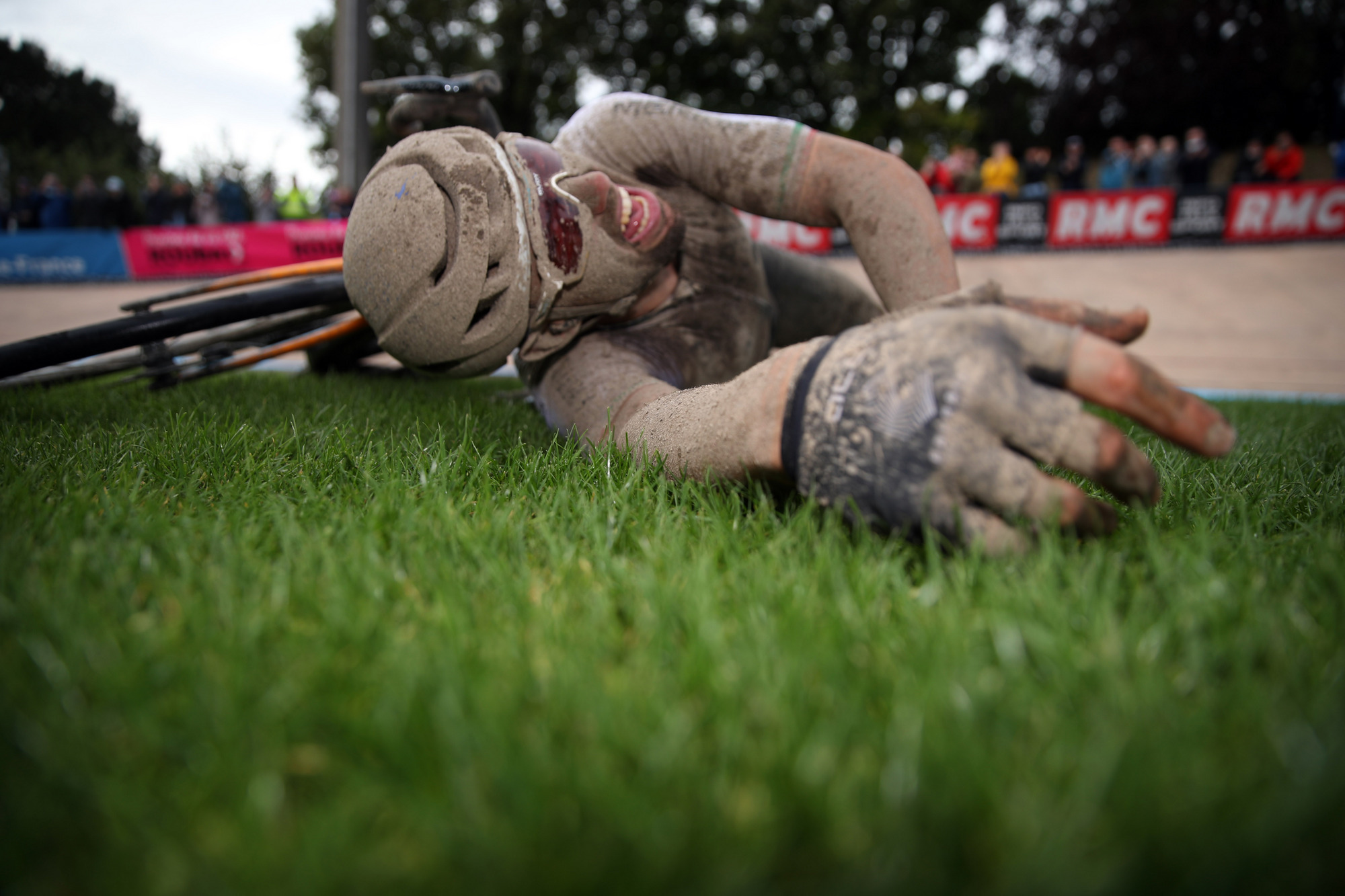
The men line up in Compiègne and, by the time they line up, it is already raining. Hard. Before they even put feet to pedals, water pools in the folds of their rain jackets, creates beads on the surfaces of their glasses, dampens their gloves.
No one is smiling. There is no reason to smile. It's a grim task ahead of them, Paris-Roubaix, even to begin with, but the rain makes everything so much more dire.
Bad weather is a given in cycling. After all, it's a sport that takes place outside and, unlike other sports, nothing is rescheduled when the weather is poor. In fact, there's a kind of bloodlust on the behalf of fans for a wet Paris-Roubaix.
A race of attrition, with 30 sectors of bone-shaking cobbles, the wet only makes what is already a holdover from a much more brutal era of cycling truly live up to its nickname: The Hell of the North.
Everyone here knows it's going to be a long and rather bad day out. If you want to win Paris-Roubaix, there are two ways of doing so: being the strongest – and all winners are strong – or being the smartest.
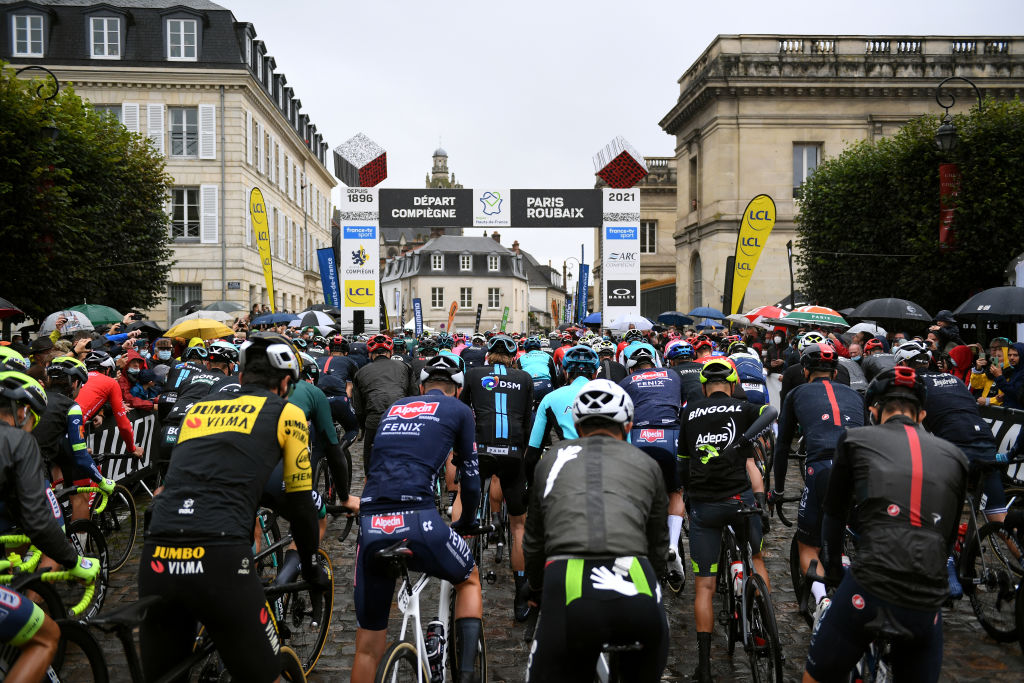
One wonders, when a 31-man breakaway sets off nearly as soon as the commissaire's flag falls, whether these men simply want to be done with the whole thing quicker than others, or whether they think a break originating before the very first cobbled sector at Troisvilles is the best vehicle for victory.
It's not so much a break as a split in the main bunch, and the composition is not one to be trifled with, featuring the likes of Classics man Greg Van Avermaet (AG2R-Citroën), ultra-rouleur Tim Declercq (Deceuninck-Quickstep) and the time trialist Stefan Bissegger (EF-Nippo). If they work together, something like this could indeed make it to the end, profiting from the chaos that will inevitably follow. Two men, however, will prove to be some of the main characters of the day: Gianni Moscon (Ineos Grenadiers) and the young Belgian Florian Vermeersch (Lotto Soudal). Remember their names.
Get The Leadout Newsletter
The latest race content, interviews, features, reviews and expert buying guides, direct to your inbox!
With almost every team having a representative in the break, the chase is lacklustre at best. No matter; things will happen, and they will happen soon. All of this is a mere prologue, taking place against a muddy backdrop of fields and tall grasses. Rain shimmers against the browning leaves of trees. This used to be a spring race, always was, until the pandemic happened and, owing to an outbreak in France in April, it was moved to the fall, ahead of the final monument of the year, Il Lombardia. It's chilly. The men shiver in their coats and prepare themselves in the quiet that these slick but smooth initial roads provide. They'll miss them by the time it's all over.
Troisvilles approaches. It's not the hardest of the cobbled sectors - by far - but it is the first and, as such, the preparation is antsy and dire. The earliest victim of the day is Marco Haller (Bahrain Victorious), who punctures. However, it's not until they reach the foot of the pavé that the crashes happen; they were bound to happen. Stefan Küng (Groupama-FDJ) is down in the breakaway. He slides out in the slick and brings some others with him. It's the first of many times the Swiss time trialist will fall today.
Troisvilles (30) ★★★
And then, with 161 kilometres left, the wait is over. The break hits – and I mean hits – the cobbles at Troisvilles with two minutes on the chasing bunch.
If you have never ridden on cobblestones - real cobblestones, deep and knobby and tortuous - it is my sincerest wish that you never have to. However, if you are from Belgium or the north of France, you probably know what it's like: the bone-rattling shaking of the body, the chattering of teeth in the mouth, the grip on the handlebars that never seems strong enough. On a descent, it's as though one's brain is being tossed around in one's skull like a cosmopolitan in a cocktail shaker.
Now imagine this, and add a steady helping of heavy rain to the equation. Imagine, if you will, trying to brake and there being no grip against the rumble, trying to hang on when the rain makes everything slippery – gloves, handlebars – trying to steer with the mud and filth pummelling the face, the dirt in the mouth sprayed up from the man in front of you who is just as unpredictable in this moment as you are.
It's not so much racing as it is surviving, not so much bike handling as it is trusting the bike to not fail you, not so much competing as it is commiserating. It is, in a word, terrible.
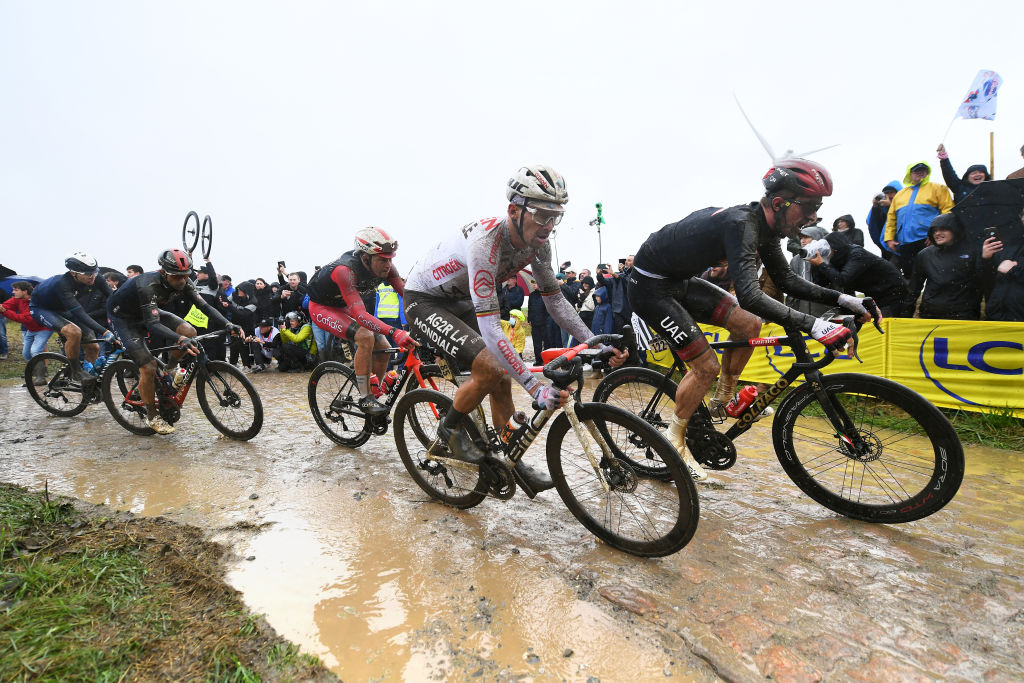
Of course, everything splits. Some riders are down but only on the sidelines and no one important. The favourites for this race, safely in the bunch behind, include the perennial duo of Wout van Aert (Jumbo-Visma) and Mathieu van der Poel (Alpecin-Fenix), once again locked in their eternal rivalry.
Other characters have emerged over the season as well: Ronde van Vlaanderen winner Kasper Asgreen (Deceuninck-Quickstep), the reformed-sprinter Sonny Colbrelli (Bahrain Victorious), not to mention former winners like Peter Sagan (Bora-Hansgrohe) and road-tested steady hands like Zdenek Stybar (Deceuninck-Quickstep), to name a few. However, Paris-Roubaix is so unpredictable that to say early on who will win is like throwing darts with a blindfold on.
With each sector, there are riders out of the breakaway. Declercq punctures at Viesly. Haller, Oss, Erviti... the names go on as the group takes hit after hit. As for the peloton, what peloton? By sector 28, there's a two-minute gap, and Van Aert and Van der Poel's forces are, like everything else, fractured.
From the break, in the chaos of sector 26 – a mere two out of five stars in difficulty – a quartet emerges ahead: Luke Rowe (Ineos), Max Walscheid (Qhubeka-NextHash), Nils Eekhoff (DSM) and Vermeersch. It's an odd group. Rowe is a consummate road captain, as gritted and experienced as they come. Walscheid, one of the biggest men in the peloton – more quarterback in appearance than cyclist – is a sprinter recently turned time triallist.
Eekhoff and Vermeersch are neophytes – both to this race and the WorldTour. There's pandemonium afoot. Sagan crashes, effectively ending the 2018 winner's day, and poor Küng hits the deck for the third time.
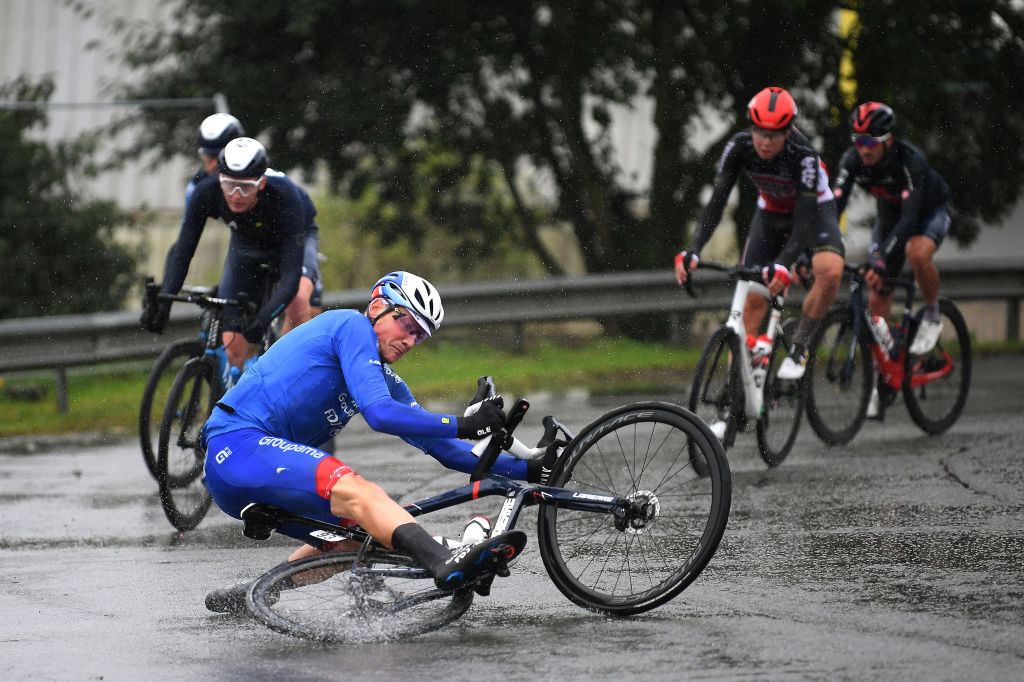
Capelle-Ruesnes (24) ★★★
Sector 24. Shortly before Rowe can't take it anymore and drops like a stone, Walscheid goes down, hard, big body tumbling over the handlebars as his bike simply slides out from under him. Sure, not everyone can be a multidisciplinary wunderkind like Van der Poel, but these are still some of the best bike handlers in the world.
Crashes in cycling, when one considers the total number of hours ridden, are relatively uncommon. However, even the best bike handlers in the world cannot control the weather, and the unpredictable surface beneath them causes fear to rise up in their chests, makes them twitchy and anxious and, to a certain extent, there is nothing they can do when misfortune and physics combine against them.
Paris-Roubaix can be won on strength. It can be won on brains. But it can be won on luck, too, which is rather unsatisfying. We want to see the best of the best make it to the finish – yet luck is as equally valid as a narrative intervention as skill. If luck had not claimed riders like Sagan or, say, a resurgent Matej Mohorič behind, this race could have turned out very differently. Could have, but didn't.
And then, emerging from the pavé of Ruesnes, at the front, there were two: Vermeersch and Eekhoff. Two young men all alone fighting for their lives against the elements and the best in the world who would like very much to catch them. They have almost a minute. It grows to almost three.
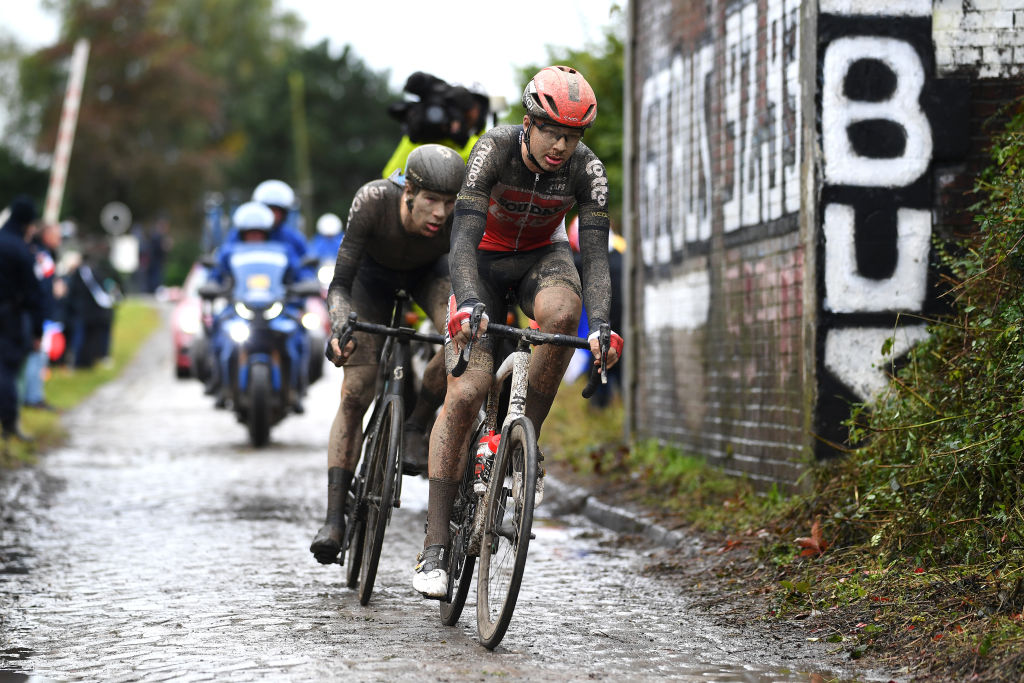
Meanwhile, in what we will generously describe as 'the bunch,' Van Aert could use a vacation. Ever since his crash in the 2019 Tour, the man's been on a constant regime of work and recovery, work and recovery. If it's not Classics season, it's the Grand Tours; if it's not the Grand Tours, it's his cyclo-cross campaign. And right now, at Paris-Roubaix, his face is plastered with mud, dark streaks from the rain and the sweat forming chasms in the grit. He's gripping his handlebars something fierce, trying to keep an eye on the rival in front of him.
Behind van Aert, in a true testament to the horribleness of the day, Christophe Laporte's (Cofidis) brakes have worn out to the point that he has to reach behind with his foot to slow his bike manually. Up front, Van Aert thinks. He waits. Sector 22. Quérénaing, three stars. It's coming just two kilometres after an earlier segment, a jolt after a jolt. The worst test will arrive soon as well, in under 20 kilometres time – four-star Haveluy, and then after that, the infamous Arenberg Trench.
Van Aert gets word of the time gaps, and probably thinks something along the lines of this has gone on long enough. They're running out of time to screw around. He makes a decision and, as soon as his front tire rattles from the pavé, he goes. Michal Kwiatkowski (Ineos) and Edoardo Affini (Jumbo-Visma) are on his wheel. Van der Poel knows this is a moment and snags on. The peloton splits. Oh, Mathieu thinks, Wout wants to have a go, hm? Why not make it difficult? When the road smooths, he pulls.
Trouée d'Arenberg (19) ★★★★★
The sound of the rain begins to thin, becomes less of a slap slap slap and more of a hiss, but this is but a small comfort. On the tarmac, the bunch starts to re-assimilate while the rivals duke it out in order to get ahead in time for a bike change before the trees rise up and make dark the road.
The closer they get to the combo of the four-star Wallers and the five-star Arenberg, things disintegrate as a result of the sheer anxiety. Max Schachmann (Bora-Hansgrohe) careens off the road and takes out two others, half of what's left of AG2R-Citroën is in a ditch at the right. Dig after dig, pull after pull, too many to mention, too many to keep track of, all in anticipation. In the wake of this fighting, the gap comes down to the now mostly forgotten chasers. The rain dissipates, and in the fog of the Arenberg Trench, the holiest site of this race, a nightmare unfolds.
The forest is dense and the trench is a trench, slicing through it, shrouded in darkness despite the cheerful plastic barriers flanking the road. The cobbles on this stretch can reach uneven heights of three inches or more, and between each is a chasm meant for snaring wheels. A BikeExchange rider is the first fly caught in the trap. The fall is sudden and hard, and it almost takes out Van Aert as well, but Van Aert is a seasoned cyclo-crosser and is able to stay up, adrenaline searing in his veins.
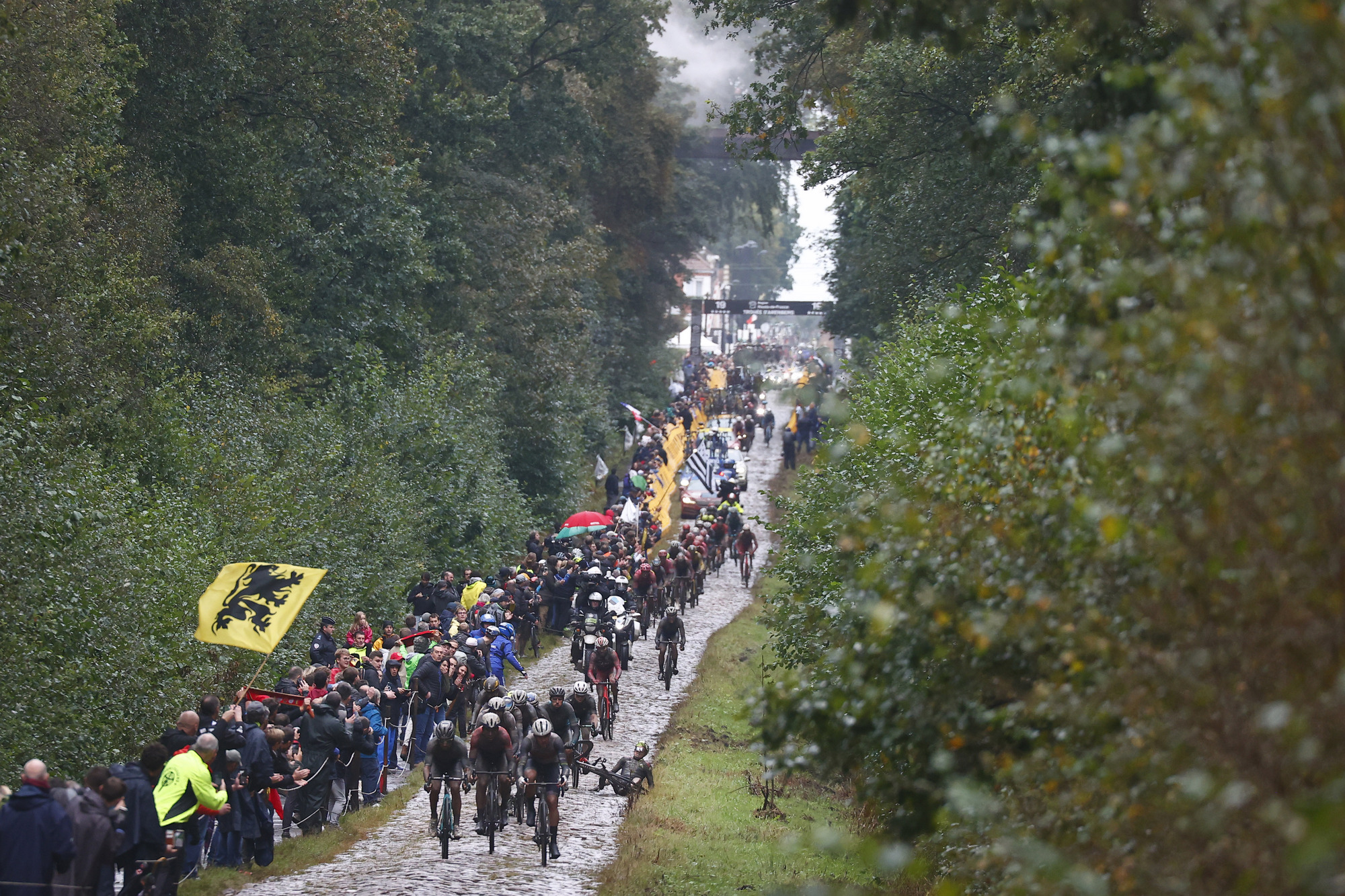
The rain has stopped and Van der Poel gets the news about Wout and he's driving, driving on, licking the dirt from his lips, passing Rowe, who has punctured and loses control. He crashes into Mads Pedersen (Trek-Segafredo), and the snarling of carbon, the bruising pain of coming down on such a surface, and Van Aert is trying, trying to get back on.
By the time the horrific shaking is over, Van der Poel has only Colbrelli, Guillaume Boivin (Israel Start-Up Nation), and Matteo Jorgensen (Movistar) for company. Where is Asgreen? Where is Lampaert? They're back with Van Aert, both having punctured. Van Aert and Van der Poel manage to regroup, but only temporarily. The break is shattered, a mere half of its original participants remaining. Colbrelli and a rider from B&B Hotels set off in search of them, hearing that there's less than a minute between themselves and company. Vermeersch and Eekhoff are reclaimed by the chasers. Boivin joins Colbrelli.
A storyline is beginning to emerge.
Tilloy (15) ★★★★
Sector 17, Hornaing, four stars. Both of Van Aert's teammates – Nathan Van Hooydonck and Timo Roosen - puncture and crash, respectively. Confusion, utter confusion as groups split and reform, as riders crash and get back on, as the sectors tick down. A beleaguered Mohorič abandons after two punctures earlier. Somehow, Walscheid is back near the front.
At 70 km to go, in pure Mathieu van der Poel fashion, the Dutchman decides, quite simply, screw this. It's a vicious acceleration on the cobbles of sector 15. Three men come with him: Stybar, Lampaert, and Haussler. Van Aert can't or won't follow, and once Van der Poel sees this, he kicks again and this time only Lampaert is able to hang on.
Van Aert's day, though he doesn't know it yet, ends here. After all the pain and the stopping and starting and the chasing and the lashing rain, there is just not enough left in the body to be able to pull things back. The race of attrition is just that, and it is relentless.
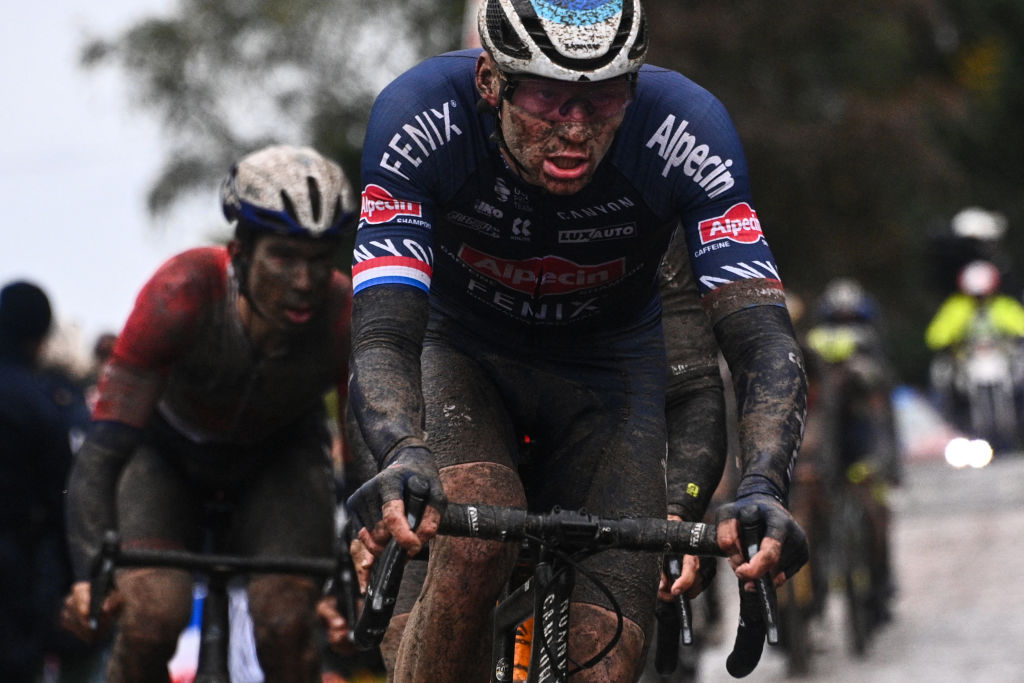
Van der Poel ditches the others, and on his crusade, he catches Colbrelli's group and passes them, but then, he has a change of heart. Perhaps the Van der Poelian tactic of going at it alone for some 70 kilometres isn't the right idea on terrain as difficult as this. He slows, rejoins Colbrelli and his four comrades and the quintet take turns, for now.
Sector 14, another kick. No one knows what's happening up front until finally, from the pavé, three emerge: Moscon, Vermeersch, and Tom Van Asbroeck. Behind, a group of Van Avermaet, Philpsen, Bissegger, Walscheid, and Van der Sande. Behind them, Van der Poel's group, which merges with Van Avermaet's after a few long pulls. Things stay like this for 10 kilometres, stable – riding hard, but stable.
With 54 kilometres left, we enter our end game.
Mons-en-Pévèle (11) ★★★★★
Sector 12, Auchy-lez-Orchies, four stars. The rain has long since ceased, but it matters not because its after-effects have still grimed up the road in wet mud and have made the pavé dangerously slick. The grit from earlier dries on the riders' faces, and when the camera zooms in on them, one can barely see their skin through all the filth. Their bikes have become brandless, their sponsors obscured on their jerseys.
Perhaps lulled into a false sense of security by the change in weather, Walscheid slips, and he takes an unsuspecting Van Avermaet and Van der Sande with him. Ahead, Moscon decides that now is his time and soon, he is alone.
Van der Poel, in the fog of upheaval, makes his selection. Only Colbrelli and Boivin go with him. As for Vermeersch and Van Asbroeck? Right now, it's a mystery.
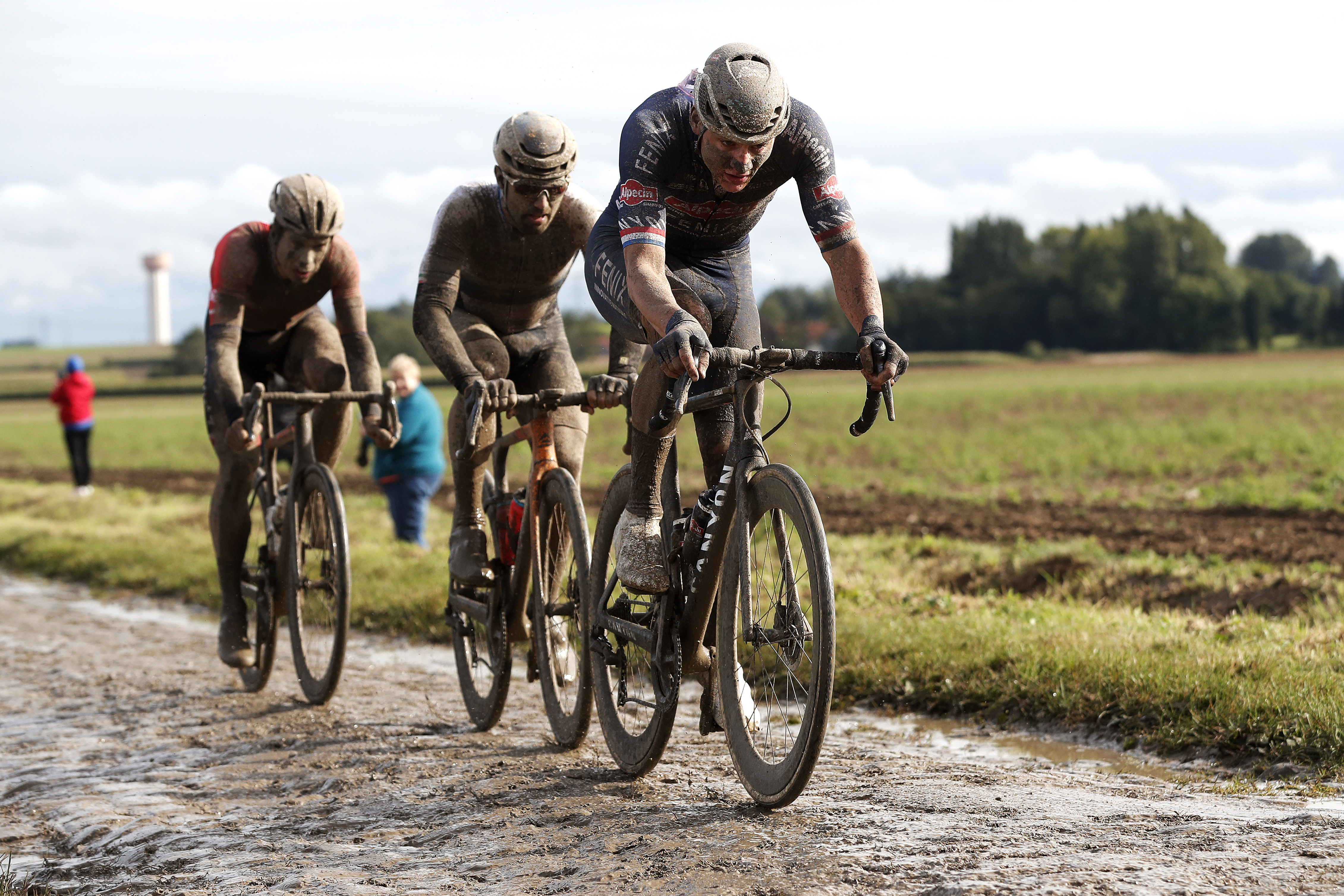
Gianni Moscon has his hands in the drops. Dirt mixes with spittle as glimpses of sun pool light into the whorls of cobblestones. The strongest member of the initial breakaway, Moscon, is, to put it delicately, not a great guy. He's best known not for his exploits on the bike but for the racial epithets he flung at Kevin Réza (who is Black) during the 2017 Tour de Romandie, the punch he flung at Élie Gesbert at the 2018 Tour de France, and the bike he flung at another rider after a crash in the 2020 Kuurne-Brussels-Kuurne.
To gloss over these incidents, to write them out of the story, is to implicitly condone them and, as a journalist, it would be wrong to do so.
However, right now, an Italian hasn't won Paris Roubaix since 1999 and Moscon is solo and he is burying himself. He pulls a minute and, this late in the game, such a gap is exceedingly difficult to reign back in. He cedes no ground to Van der Poel and his comrades. Even on the hellish stones of Mons-en-Pévèle, the seconds do not tick down.
Water flanks the road and the mud is so thick it forms a blanket over the cobblestones, and yet, Moscon, on resplendent form, is able to emerge unscathed from one of this race's most brutal tests.
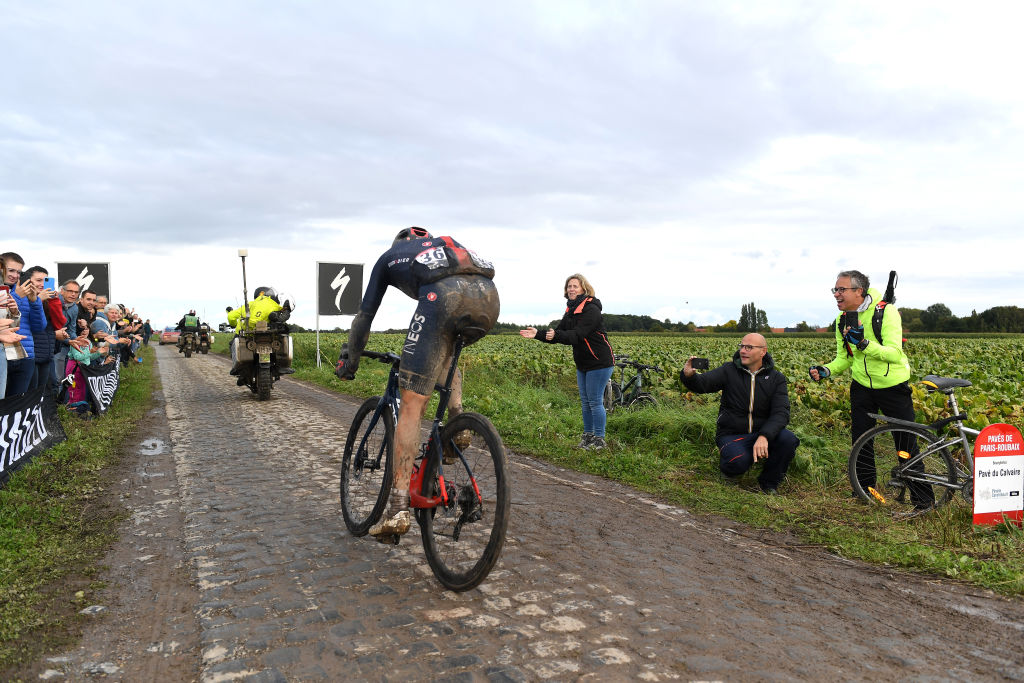
Behind, Van der Poel works. Hard. He's taken things into his own hands, trusts no one else to do so. This is one of the most admirable things about him, this ability to persevere, this complete and utter faith in himself, the romantic spirit of an individual racing his bike in the purest sense of the term. He's not counting his calories, he's not participating in some grand Machiavellian game of wattages and spent teammates. He's racing, everyone else be damned. For a man like that, Paris-Roubaix is a fine play to act in, and in it, 10 sectors - 10 scenes, if you will - remain.
After finishing the 10th, Moscon perhaps starts to believe. There's still almost a minute and a half between him and the others. And he's strong, really strong. It's the best showing of his season, to the point where he makes the cobblestones look easy, rides over them with relaxed confidence. With under 40 kilometres to go, it genuinely looks as though no one can stop him.
Meanwhile, Vermeersch and Van Asbroeck are caught by the steady pace of Van der Poel's group. Something about this puts a fire in the Dutchman. Something about this makes him believe that it can all come back, will come back. Van der Poel commits himself to the task of hunting Moscon down. It's a battle between two riders, time, and the gnarly road beneath their wheels.
Moscon, however, is feeling damn good. His sports director, Servais Knaven, gives a rather cocky thumbs up from the team car as the camera bike goes by. To be honest, the race looks over. The time gap hovers right at a minute, and with each sector of pavé tackled, the others are running out of road.
Cysoing (7) ★★★
And then, with just 30 kilometres left in the game – call it karma or don't, I'm not the arbiter of your narrative moral compass – Moscon punctures.
The seconds tick by. It's a bike change. One minute shrinks to 45 seconds. Still daylight. But there's another problem. The pressure in the tires of his new bike is too high and the Italian is practically bouncing along the cobbles in sector 7. It's hard to control, he's bumping along, his hands gripping the hoods with violence.
The crash is inevitable. And that's it.
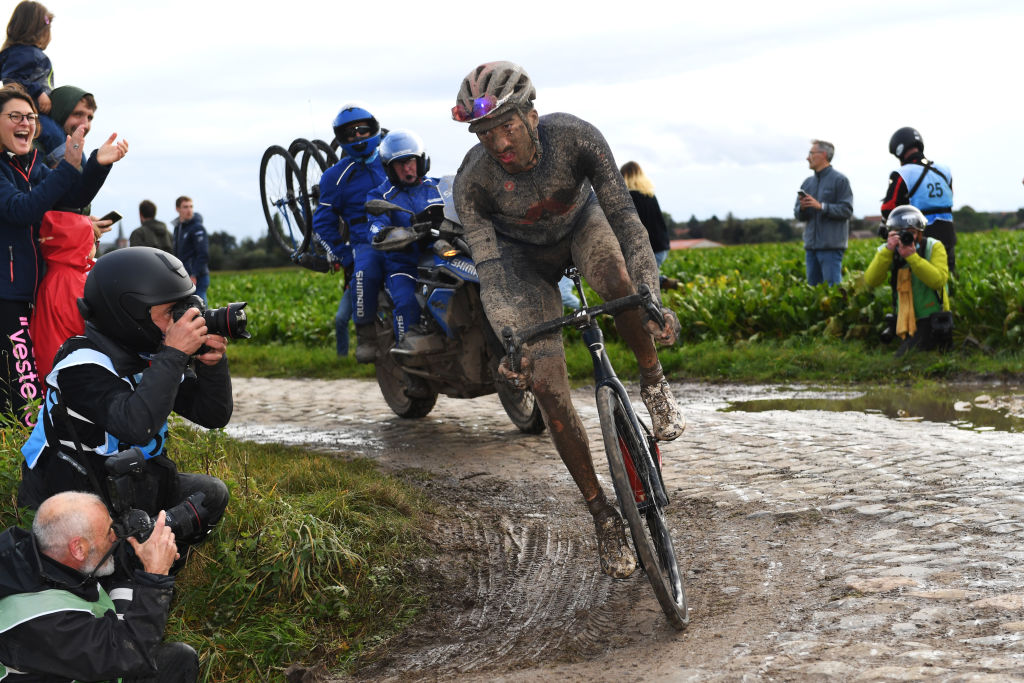
Like I said earlier, this race can be won on strength or brains, but in Paris-Roubaix, luck is often the arbiter of fate. 12 seconds left for the Italian. Still, it is agonizing, watching Van der Poel and company try and pull it back. For a moment, it almost appears like Moscon will get away with this after all, but the aching perseverance pays off, albeit in the span of a long, long 10 kilometres.
Sector 5. There's a problem, another one. Moscon's rear mech is bent, limiting the number of gears he can change into. He slides, but saves it by a hair. One can't say the same for Boivin, who crashes, or Van Asbroeck, who is distanced when young Vermeersch decides to take a pull.
Carrefour de l'Arbre (4) ★★★★★
17 kilometres to go, and here it is: the Carrefour de l'Arbre, five stars, one of the worst stretches of the day.
Once Moscon is caught, his morale drops like a stone, and so, too, does he. All it takes is Sonny Colbrelli making a move. For Moscon, it was a thrilling battle, but this is a war of attrition, and there's only so much one can be beaten down. The remaining three: Van der Poel, Vermeersch, and Colbrelli. If the Carrefour can't make the selection – and everyone riding those cobbles will try – this will go to the Roubaix velodrome.
Florian Vermeersch is 22 years old. Bright and well-rounded, the young Belgian is, in addition to being a professional cyclist, a student at the University of Ghent in the history department, and a volunteer in his local neighbourhood council. A podium finisher in this year's Worlds U23 time trial and a cyclo-crosser by night, he's as suited to both the long pulls in the wind and the treacherous roads of Paris-Roubaix as they come. It's his second year as a professional cyclist with Lotto Soudal, a recruit from their development team and behold, here he is up front with the likes of Mathieu Van der Poel and Sonny Colbrelli, two strongmen with the advantage in a sprint.
Imagine being Florian Vermeersch. Imagine being out in the break all day, enduring the grime and the crashes and the mud and being dropped and finding time after time assorted groups of people who help to pull you back into this race that just never stops. Imagine ending up with two of the race favourites in the finale, speeding towards the famous Roubaix velodrome, as consummate an underdog as there ever was. It's the ride of his young life and it promises a successful future. By the end of it, the world will know him. By the end of it, his own world will be irrevocably changed.
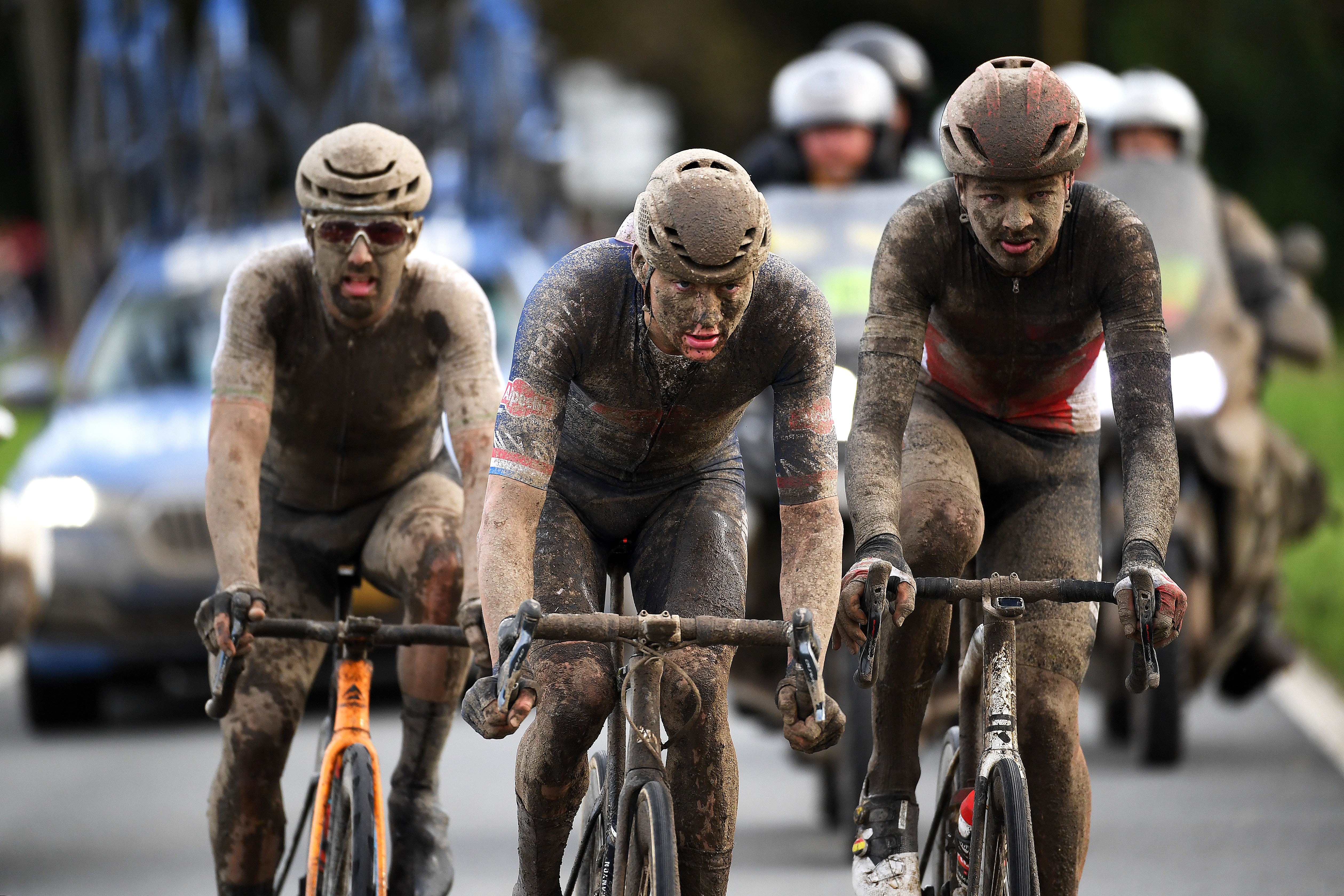
The three work. Well, two of them work. Van der Poel's habit of taking control and Vermeersch's wariness that he'll have to make a move at some point lest he end up in a – let's face it – not very favorable sprint both make the situation very appealing for a certain Sonny Colbrelli. The Italian champion has had a hell of a season. At 31, his best years appeared to have been behind him.
A fixture of Bahrain Victorious since its very inception, everyone, well, kind of forgot about him. That is, until he finished top-10 in Kuurne-Brussels-Kuurne, Milano-Sanremo and Gent-Wevelgem. He hid during the rest of Classics season but emerged once more at the Tour de Romandie where he won the points jersey, a success he followed with claiming that same prize in the Critérium du Dauphiné. Then, the winning never stopped. The Italian National Championships, Benelux Tour, the European Championships, Memorial Marco Pantani. He claimed them all.
Colbrelli's recipe for success perhaps owes itself to his shift away from being a pure sprinter to more of a Peter Sagan type who can hash it out on the hilly courses as well. Though he's by no means the strongest sprinter in the bunch anymore - a tradeoff for his climbing abilities - he is one of the smartest. One could even say he's craven. He wins by being where he needs to be and working only as hard as he has to. Right now, at Paris-Roubaix, he finds himself in just that same favourable condition once more.
Van der Poel. Vermeersch. Colbrelli. It's anyone's game, the race itself being the great equalizer.
Van der Poel is ostensibly the mightiest, but a day spent clawing back break after break has left him fatigued and cagey. Vermeersch hasn't had to do much chasing in comparison, he's mostly ridden where he's ridden and rejoined with others to move himself back to the front of the race, where, if one recalls, he originally spent a good deal of his day. Colbrelli isn't a pure cobbles man nor a pure sprinter, but he's survived, and right now, he isn't working, that is, until Vermeersch takes a desperate flyer at 3.2km to go and only the Italian has the legs to snag him.
Vélodrome André-Pétrieux, Roubaix
The velodrome approaches. They turn into it. The grey clouds part, finally, for sun. The still-wet concrete beneath their wheels, which spray water in their wake. The favourite, the outsider, the underdog, they slow. Moscon follows them a bit later, clogs up the track, a lap behind. The bell tolls. One lap.
Of course, it's Vermeersch who leads it out. He has to. It's his only shot. He has to hope that Van der Poel and Colbrelli will mark each other out of contention. Fat chance, the prize is too big. Three up they go, and it's Van der Poel, Van der Poel, but Moscon is in the way and the Dutchman has to spend energy he doesn't have to get around him.
He throws himself with everything and Vermeersch? His eyes are slack in their sockets as he sends his bike fast across the line – but there is only one man, poised right in the middle, who has played the game better, who has retained enough of himself to devote every cell, every ounce of grip and muscle and soul to crossing that finish before the rest, and it is Sonny Colbrelli, the first Italian in 22 years, who wins Paris-Roubaix 2021.
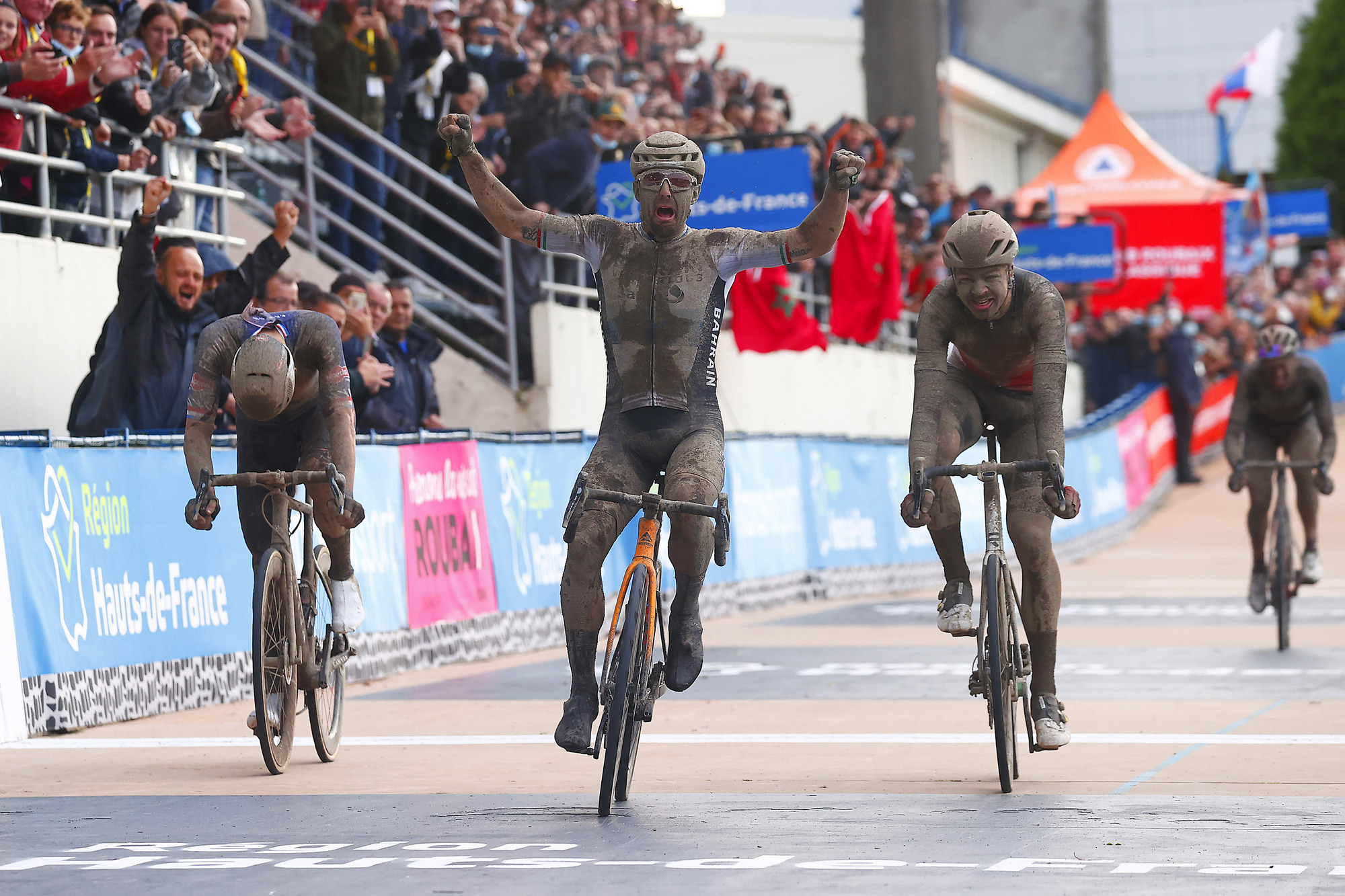
Colbrelli knows. He screams, a primal sound of triumph. He dismounts and lifts his bike over his head, victorious, before collapsing onto the grass in tears.
Despite the toil and the suffering, it is, perhaps the greatest day of his life. No prize he's ever won has come even remotely close to this. Perhaps no prize ever will. In second, it's Vermeersch, who, by way of a single afternoon in Hell has made a name for himself. Van der Poel, despite his commendable and profound effort, could only do so much after spending everything too soon.
It's a classic Paris-Roubaix win, and a satisfying ending to a story that would have been, perhaps, too on the nose if either the favourite or the massive underdog prevailed. Too much of a fairytale.
Tears etch valleys in the mud on Colbrelli's face. He grabs his nearest teammate, Heinrich Haussler, who's just finished 10th, and buries his head in his shoulder. Van der Poel lies in a crumple on the ground, devastated. Vermeersch, realizing the magnitude of what he's just accomplished, is also in tears. Three lives, altered.
For the rest, it is merely over, and that too is its own prize. For this is a race of survival and the ones who finish walk away with the experience of overcoming.
That's the thing about Paris-Roubaix. One could say that Sonny Colbrelli won this race. One could also say he simply survived a Sunday in Hell the hardest.
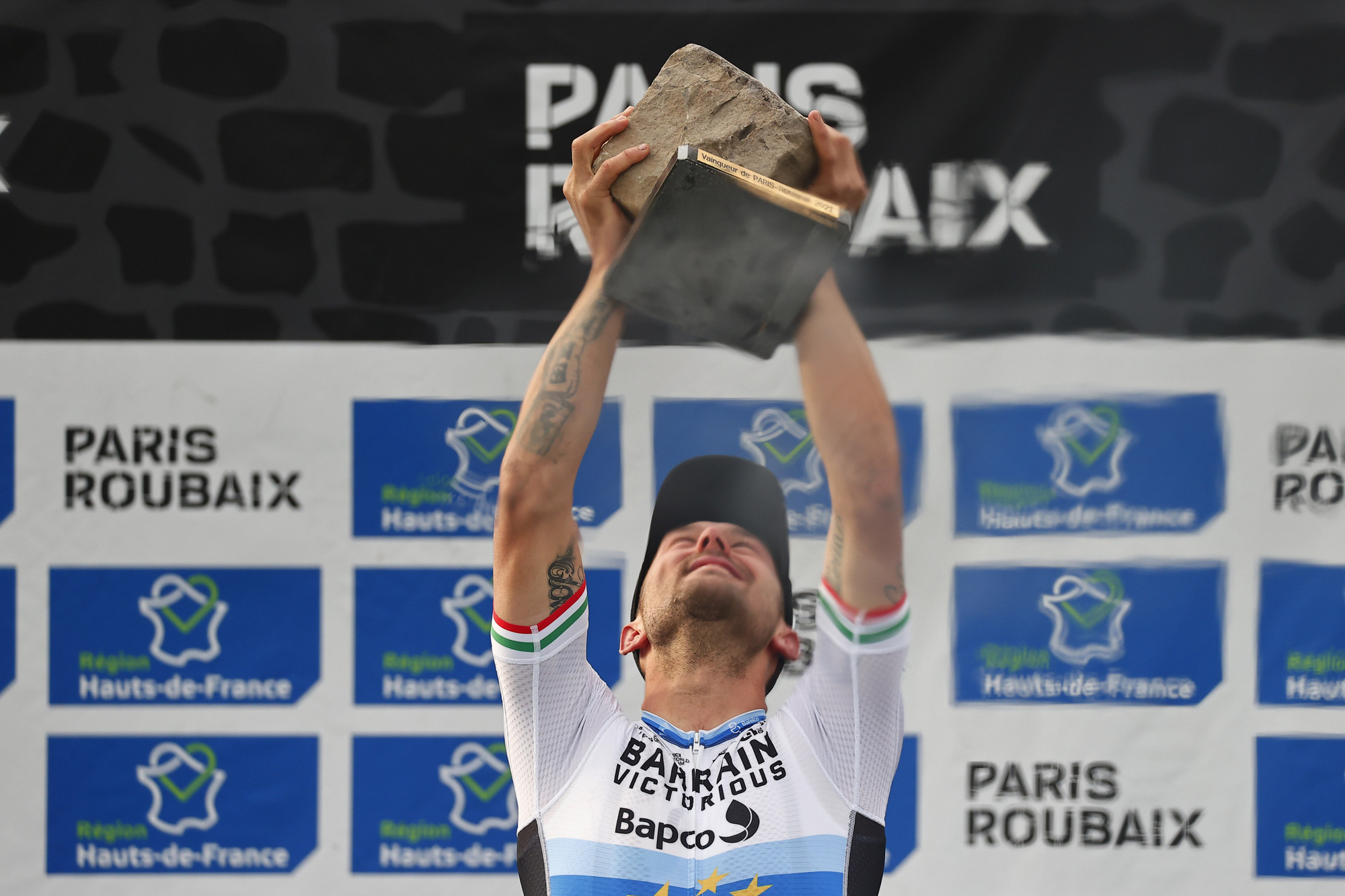
Kate Wagner is a Chicago-based writer and critic. Her work on cycling can be found in various publications including Procycling. Her newsletter covers cycling in an unconventional fashion, featuring essays, short stories, multimedia works and illustration.
She can be found Tweeting at @derailleurkate